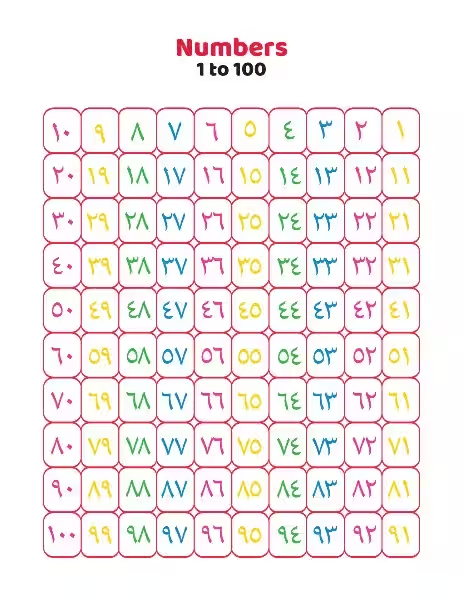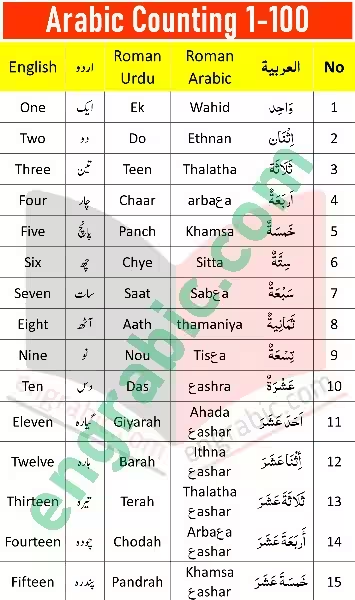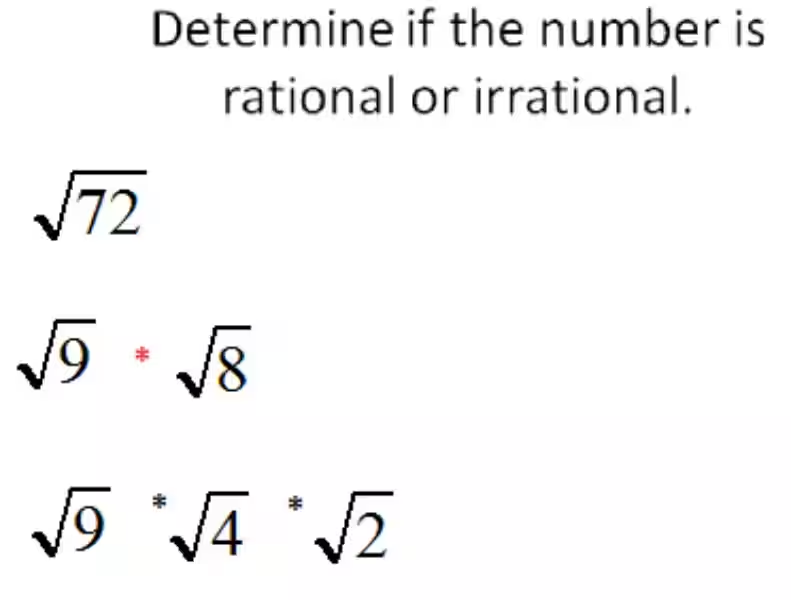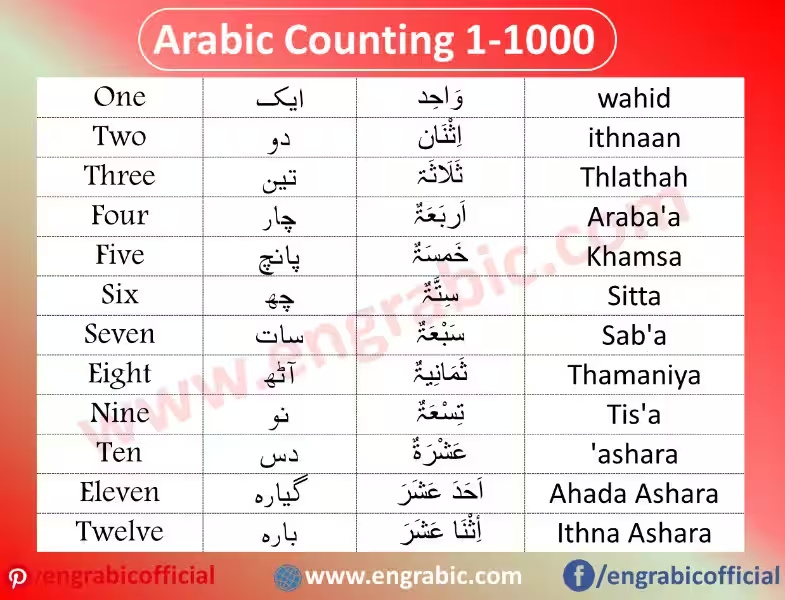
Arabic, a language rich in history and culture, boasts a fascinating number system that is both logical and beautiful. Understanding Arabic numerals is crucial for navigating the Arabic-speaking world, whether you’re exploring literature, interacting with locals, or simply appreciating the intricacies of the language. This article delves into the world of Arabic numbers, focusing on numbers from 1 to 100, and guiding you through the patterns and intricacies that make this system unique.
A Journey from 1 to 10: The Building Blocks of Arabic Numbers
The journey begins with the first ten numbers, the foundation upon which the entire system rests. These numbers are unique and essential to memorize. They form the basis for all subsequent numbers, serving as building blocks for larger quantities.
The First Ten Numbers:
| Arabic numeral | Arabic script | Transliteration |
|---|---|---|
| 1 | واحد | wāḥid |
| 2 | اثنان | ithnān |
| 3 | ثلاثة | thalātha |
| 4 | أربعة | arbaʿa |
| 5 | خمسة | khamsa |
| 6 | ستة | sita |
| 7 | سبعة | sabʿa |
| 8 | ثمانية | thamānīya |
| 9 | تسعة | tisʿa |
| 10 | عشرة | ‘ashara |
Remember that the Arabic script is written from right to left, while the numerals are written from left to right, just like in English. This might be confusing at first, but it becomes second nature with practice.
From 11 to 19: The “Teen” Numbers
Numbers 11 to 19 follow a consistent pattern, making them relatively easy to learn. The structure is simple: the single numeral is followed by “‘ashara” (ten).
The Teen Numbers:
| Arabic numeral | Arabic script | Transliteration |
|---|---|---|
| 11 | أحد عشر | aḥad ‘ashar |
| 12 | اثنا عشر | ithnā ‘ashar |
| 13 | ثلاثة عشر | thalātha ‘ashar |
| 14 | أربعة عشر | arbaʿa ‘ashar |
| 15 | خمسة عشر | khamsa ‘ashar |
| 16 | ستة عشر | sita ‘ashar |
| 17 | سبعة عشر | sabʿa ‘ashar |
| 18 | ثمانية عشر | thamānīya ‘ashar |
| 19 | تسعة عشر | tisʿa ‘ashar |
Notice how the “‘ashara” remains constant, while the first part of the number changes to reflect the corresponding single digit. This consistent pattern simplifies the learning process.
The Decades: 20 to 90
The decades from 20 to 90 follow a similar pattern, with the single numeral being attached to the root “‘ishrun” (twenty). This pattern is essential for understanding numbers beyond 19.
The Decades:
| Arabic numeral | Arabic script | Transliteration |
|---|---|---|
| 20 | عشرون | ‘ishrun |
| 30 | ثلاثون | thalāthūn |
| 40 | أربعون | arbaʿūn |
| 50 | خمسون | khamsūn |
| 60 | ستون | sittūn |
| 70 | سبعون | sabʿūn |
| 80 | ثمانون | thamānūn |
| 90 | تسعون | tisʿūn |
The suffix “oon” or “een” is added to the single numeral to form the decades. This simple rule significantly simplifies the process of learning the numbers from 20 to 90.
The Century Mark: 100 – Me•’aa (مائة)
The number 100 is a milestone in Arabic numerals, marking the transition from tens to hundreds. It is pronounced “Me•’aa” (مائة) in Modern Standard Arabic and “meyya” (مية) in spoken Arabic. This number is the foundation for all numbers in the hundreds.
Beyond 100: Building Larger Numbers
Numbers beyond 100 are constructed by combining the single digit, the ten, and the hundred, using the conjunction “wa” (and) as a separator. For example, 123 would be “Me•’aa wa-ithnān wa-thalātha” (one hundred and two and three).
The Hundred’s Club: Numbers in the 100s
Numbers in the 100s follow a consistent pattern: “hundreds (and) singles (and) tens”. For example, 234 is pronounced “mithnān Me•’aa wa-arbaʿa wa-thalāthūn” (two hundred and four and thirty). The order of the words is significant, ensuring clarity and logical progression.
Multiplying the Hundreds: A Simple Formula
Multiplying the hundreds involves combining the single numeral with “Me•’aa” (مائة). For example, 300 is “thalāth Me•’aa” (three hundreds). This simple rule ensures consistency and makes learning the hundreds easier.
The Special Case of Two Hundred: A Unique Plural
The number “two hundred” (200) follows a different plural rule, ending in “ein” instead of “oon”. It is pronounced “mithnān Me•’aa” (two hundreds). This exception is important to remember, as it deviates from the standard pattern.
Exploring Arabic Numbers: A Gateway to a Rich Culture
Arabic numerals are not just a system for counting; they are a window into the rich history and culture of the Arabic-speaking world. By learning Arabic numbers, you are opening the door to a world of literature, music, art, and traditions. Embrace the beauty and logic of this fascinating number system, and embark on your journey into the world of Arabic language and culture.
Frequently Asked Questions About 100 in Arabic
How is 100 pronounced in Arabic?
In Modern Standard Arabic, it’s pronounced “Me•’aa” (written مائة). In spoken Arabic, it’s often pronounced “meyya” (مية).
How do you write 100 in Arabic numerals?
It is written as 100, just like in English.
How do you count numbers in the 100s in Arabic?
Numbers in the hundreds follow the pattern “hundreds (and) singles (and) tens”. For example, 123 would be “one hundred (and) twenty (and) three.”
How do you multiply a single numeral with 100?
You combine the single numeral with “Me•’aa” (مائة). For example, “two hundred” is “Me•’aa•tain” (مائتان).
How is “two hundred” different from other multiples of 100?
It follows a different plural rule, ending in “ein” instead of “aa”.
- Arabic numerals are written from left to right, despite the Arabic script being right to left.
- The Arabic numeral system is based on the Indo-Arabic numeral system, shared across all Arab countries.
- Numbers 1-10 have unique pronunciations, while numbers 20-90 follow a pattern of adding the suffix “oon” or “een” to the single numeral.
- Numbers beyond 20 are constructed by saying the single digit first, then the ten, separated by “wa” (and).
- 100 is pronounced “Me•’aa” (written مائة) in Modern Standard Arabic and “meyya” (مية) in spoken Arabic.
- Numbers in the 100s follow the pattern “hundreds (and) singles (and) tens”.
- Multiplying the hundreds involves combining the single numeral with “Me•’aa” (مائة).
- The number “two hundred” follows a different plural rule, ending in “ein”.
- Arabic numbers and Arabic numerals are different.
- The “TH” sound in Arabic numbers can be voiced (like “there”) or unvoiced (like “thumb”).
- Arabic dialects exist, but the written form and basic structure of numbers remain consistent.
- For the numbers 21 to 29, the structure is “number + wa- + ‘ishrun”, meaning “number and twenty”.
- For example, “21” is “wāḫed wa-’ishrun”, meaning “one and twenty”.
- Numbers from 100 to 1000 are formed by combining the numbers for hundreds, tens, and units.
- For example, “234” is “mith-tain wa-thalatha wa-arba’un”, meaning “two hundred and three and forty”.
- The number “1000” is pronounced “alf” (ألف) in Modern Standard Arabic.
- Numbers in the thousands are formed by combining the number for thousands, hundreds, tens, and units.
- For example, “2345” is “alfain wa-thalatha-mith-ain wa-arba’un wa-khamsa”, meaning “two thousand and three hundred and forty and five”.
- The number “10000” is pronounced “’ashara al-’uf” (عشرة آلاف) in Modern Standard Arabic.
- Numbers in the ten thousands are formed by combining the number for ten thousands, thousands, hundreds, tens, and units.
- For example, “23456” is “’ishara al-’ufain wa-thalatha-mith-ain wa-arba’un wa-khamsa wa-sitta”, meaning “ten thousand and two and three hundred and forty and five and six”.
- The number “100000” is pronounced “mi’at al-’uf” (مئة ألف) in Modern Standard Arabic.
- Numbers in the hundred thousands are formed by combining the number for hundred thousands, ten thousands, thousands, hundreds, tens, and units.
- For example, “234567” is “mi’at al-’ufain wa-thalatha wa-arba’un wa-khamsa wa-sitta wa-sab’a”, meaning “hundred thousand and two and thirty and forty and five and six and seven”.
- The number “1000000” is pronounced “milyun” (مليون) in Modern Standard Arabic.
- Numbers in the millions are formed by combining the number for millions, hundred thousands, ten thousands, thousands, hundreds, tens, and units.
- For example, “2345678” is “milyunain wa-thalatha-mith-ain wa-arba’un wa-khamsa wa-sitta wa-sab’a wa-thamania”, meaning “two million and three hundred thousand and forty and five and six and seven and eight”.
- Arabic is a Semitic language, and the Arabic number system is closely related to those of other Semitic languages, such as Hebrew and Aramaic.
- The article encourages learners to explore Arabic grammar and resources available on Preply’s blog and app.
- It also provides links to learn Arabic online and through apps.








